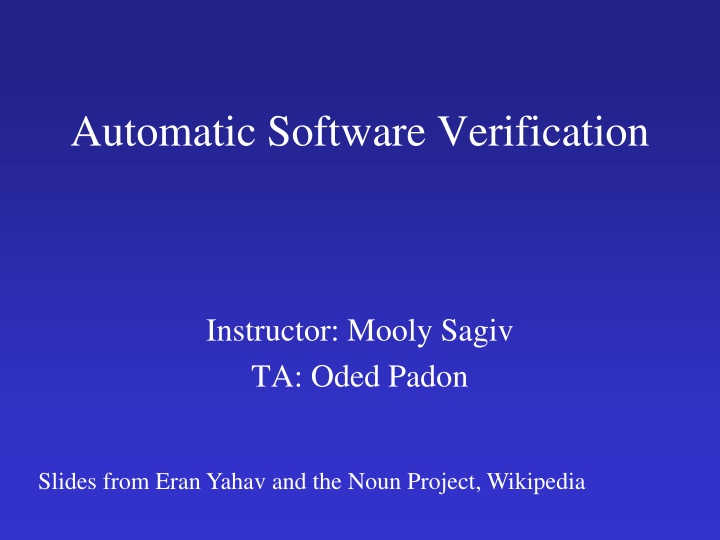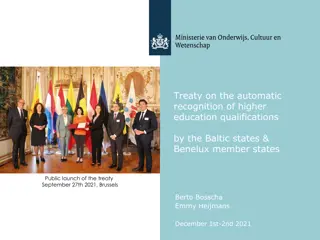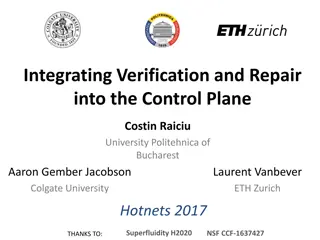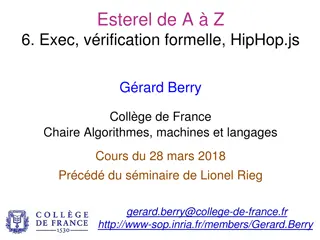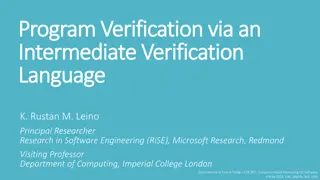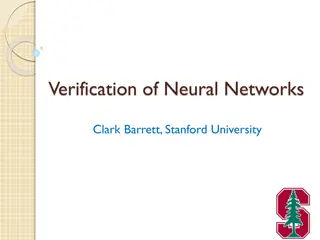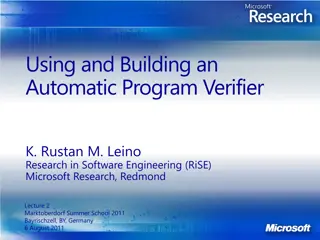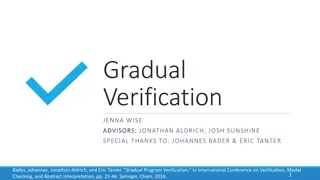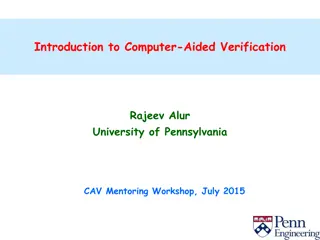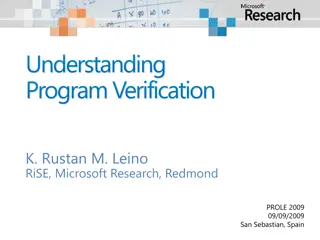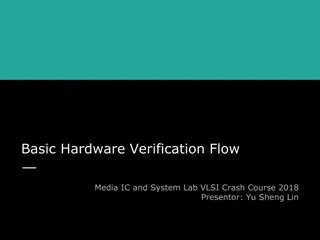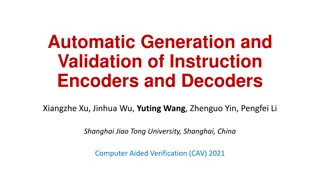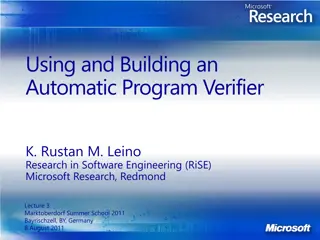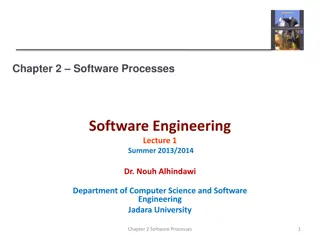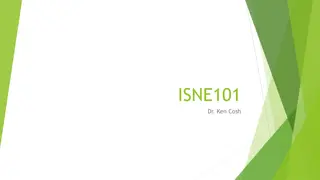Automatic Software Verification Essentials
Delve into the world of automatic software verification with this comprehensive course covering topics such as buffer overruns, exploits, and program properties. Explore real-world examples and learn about tools and techniques for ensuring software security and correctness.
Download Presentation

Please find below an Image/Link to download the presentation.
The content on the website is provided AS IS for your information and personal use only. It may not be sold, licensed, or shared on other websites without obtaining consent from the author.If you encounter any issues during the download, it is possible that the publisher has removed the file from their server.
You are allowed to download the files provided on this website for personal or commercial use, subject to the condition that they are used lawfully. All files are the property of their respective owners.
The content on the website is provided AS IS for your information and personal use only. It may not be sold, licensed, or shared on other websites without obtaining consent from the author.
E N D
Presentation Transcript
Automatic Software Verification Instructor: Mooly Sagiv TA: Oded Padon Slides from Eran Yahav and the Noun Project, Wikipedia
Course Requirements Summarize one lecture 10% one lecture notes 45% homework assignment 45% exam/project
Inspired by Other Courses CS395T: Automated Logical Reasoning (UT Austin) Isil Dillig SAT/SMT Solver and Applications Graduate Seminar W2013 University of Waterloo (Vijay Ganesh)
Software is Everywhere Exploitable
Buffer Overrun strcpy void foo (char *x) { char buf[2]; strcpy(buf, x); } int main (int argc, char *argv[]) { foo(argv[1]); } > ./a.out abracadabra Segmentation fault foo main source code return address da Saved FP ca char* x ra buf[2] ab terminal memory
Buffer Overrun Exploits int check_authentication(char *password) { int auth_flag = 0; char password_buffer[16]; strcpy(password_buffer, password); if(strcmp(password_buffer, "brillig") == 0) auth_flag = 1; if(strcmp(password_buffer, "outgrabe") == 0) auth_flag = 1; return auth_flag; } int main(int argc, char *argv[]) { if(check_authentication(argv[1])) { printf("\n-=-=-=-=-=-=-=-=-=-=-=-=-=-\n"); printf(" Access Granted.\n"); printf("-=-=-=-=-=-=-=-=-=-=-=-=-=-\n"); else printf("\nAccess Denied.\n"); } } (source: hacking the art of exploitation, 2ndEd )
Attack evil input Application AAAAAAAAAAAA-=-=-=-=-=-=-=-=-=-=-=-=-=- Access Granted. 65 -=-=-=-=-=-=-=-=-=-=-=-=-=-
Automatic Program Verification Program P Desired Properties Solver Is there a behavior of P that violates ? Counterexample Proof
Example int check_authentication(char *password) { int auth_flag = 0; char password_buffer[16]; strcpy(password_buffer, password); if(strcmp(password_buffer, "brillig") == 0) auth_flag = 1; if(strcmp(password_buffer, "outgrabe") == 0) auth_flag = 1; return auth_flag; } int main(int argc, char *argv[]) { if(check_authentication(argv[1])) { printf("\n-=-=-=-=-=-=-=-=-=-=-=-=-=-\n"); printf(" Access Granted.\n"); printf("-=-=-=-=-=-=-=-=-=-=-=-=-=-\n"); else printf("\nAccess Denied.\n"); } }
Undecidability The Halting Problem Does the program P terminate on input I Rice s Theorem Any non-trivial property of partial functions, there is no general and effective method to decide if program computes a partial function with that property
Handling Undecidability Permits occasional divergence Limited programs (not Turing Complete) Unsound Verification Explore limited program executions Incomplete Verification Explore superset of program executions Programmer Assistance Inductive loop invariants
Limited Programs Finite state programs Finite state model checking Explicit state SPIN, CHESS Symbolic model checking SMV Loop free programs Configuration files
Unsound Verification Dynamic checking Valgrind, Parasoft Insure, Purify, Eraser Bounded Model Checking Concolic Executions
The SAT Problem Given a propositional formula (Boolean function) =(a b) ( a b c) Determine if is valid Determine if is satisfiable Find a satisfying assignment or report that such does not exit For n variables, there are 2n possible truth assignments to be checked Effective heuristics exit a 0 1 b b c c c c 0 1 1 0 1 1 0 0 0 1 0 1
Bounded Model Checking Input Bound k Desired Properties Program P FrontEnd Propositional Formula P(k) SAT Solver UNSAT Assignment
A Simple Example Program Constraints SAT counterexample found! int x; int y=8,z=0,w=0; if (x) z = y 1; else w = y + 1; assert (z == 5 || w == 9) y = 8, z = x ? y 1 : 0, w = x ? 0 :y + 1, z != 5, w != 9 y = 8, x = 1, w = 0, z = 7
A Simple Example Program Constraints UNSAT Assertion always holds! int x; int y=8,z=0,w=0; if (x) z = y 1; else w = y + 1; assert (z == 7 || w == 9) y = 8, z = x ? y 1 : 0, w = x ? 0 :y + 1, z != 7, w != 9
Summary Bounded Model Checking Excellent tools exist (CBMC, Alloy) Many bugs occur on small inputs Useful for designs too Scalability is an issue Challenging features Bounded arithmetic Pointers and Heap Procedures Concurrency
Concolic Testing Combine runtime testing and symbolic execution Runtime testing Effectiveness depends on input test Symbolic Execution read(x); y = 2 * x ; assert y != 12; Need constraint solver Can be complex Concolic testing aims to improve both
A Motivating Example void f(int x, int y) { int z = 2*y; if (x == 100000) { if (x < z) { assert(0); /* error */ } } }
The Concolic Testing Algorithm Classify input variables into symbolic / concrete Instrument to record symbolic vars and path conditions Choose an arbitrary input Execute the program Symbolically re-execute the program Negate the unexplored last path condition F T Is there an input satisfying constraint
Example Concolic Testing void f(int x, int y) { int z = 2*y; if (x == 100000) { if (x < z) { assert(0); /* error */ } } }
Summary Concolic Testing Quite effective: SAGE (Microsoft Research) Datarace detection (Candea, EPFL) Instrumentation can be tricky Scalability is an issue Coverage is an issue Limitations of theorem provers Data structures
Invariant An assertion I is an invariant at program location if I holds whenever the execution reaches this location An invariant is inductive at a loop while B do C if whenever C is executed on a state which satisfies B and I it can only produce states satisfying I
Temporary Cycle Creation first n n n last rotate(List first, List last) { if ( first != NULL) { last next = first; first = first next; last = last next; last next = NULL; } } first n n n last n first n n n last n first last n n n n first last n n n
Inductive Invariants x = 2; while true do {x >0} x = 2* x - 1 Inductive Non-inductive x>1 x>0
Deductive Verification Candidate Invariant inv Program P Goal F VC gen Inv is inductive w.r.t. P Inv F SAT Solver Proof Counterexample
Summary Deductive Verification Existing Tools ESCJava, Dafny, CAVEAT Hard to write inductive invariants Need to consider all corner cases Small program change can lead to huge change in the invariant The lack of specification languages Deduction can be hard
Deduction x = 2; while true do {x >1} x = (2*x*x + x 1) / (x + 1)
Transition Systems The program semantics can be described as (potentially infinite) graph of reachable states Values of program variables Program statements and conditions are relations between states Proving a safety property usually means showing that certain state cannot be reached A bad reachable state indicate a bug Bounded model checking and concolic testing explore subsets of reachable states
Example Transition System pc:x 1: x = 2; 2: while true do 3: x = 2* x 1 4: 1: 0 2: 2 2: 3 2: 5 3: 2 3: 3 4: 3 4: 5
Abstract Interpretation Automatically prove that the program is correct by also considering infeasible executions Abstract interpretation of program statements/conditions Conceptually explore a superset of reachable states Sound but incomplete reasoning Automatically infer sound inductive invariants
Automatic Program Verification Program P Desired Properties Solver Is there a behavior of P that violates ? Unknown Counterexample Proof
Interval Based Abstract Interpretation pc: int(x) 1: x = 2; 2: while true {x > 0} do 3: x = 2* x 1 4: 1: [0, 0] 2: [2, 2] 2: [2, 3 ] 3: [2, 2] 4: [3, 3]
Interval Based Abstract Interpretation pc: int(x) 1: x = 2; 2: while true {x > 0} do 3: x = 2* x 1 4: 1: [0, 0] 2: [2, 2] 2: [2, ] 3: [2, 2] 3: [2, ] 4,:[3, ] 4: [3, 3]
Interval Based Abstract Interpretation pc: int(x), int(y) 1: x = 2, y = 2 2: while true {x =y} do 3: x = 2* x 1, y = 2*y -1 4: 1: [0, 0], [0, 0] 2: [2, 3 ], [2, 3] 2: [2, 2], [2, 2] 3: [2, 2], [2, 2] 4: [3, 3], [3, 3]
Shape-Based Abstract Interpretation node search(node h, int v) { 1: node x = h; 2: while (h != NULL) { 3: if (x->d == v) return x; 4: assert x != null; x = x->n ; } 5: return (node) NULL n 1:: 1:: h h n h 2:: h 2: x h 3,4: h 3,4:: x
Shape-Based Abstract Interpretation node search(node h, int v) { 1: node x = h; 2: while (x != NULL) { 3: if (x->d == v) return x; 4: assert x != null; x = x->n ; } 5: return (node) NULL n 1:: 1:: h h n h 2: h 2:: x n 2:: h n h 3,4:: x n n 2:: 2:: h h n n
Odd/Even Abstract Interpretation 1: ? 1: while (x !=1)do { 2: if (x %2) == 0 { 3: x := x / 2; } else { 4 : x := x * 3 + 1; 5: assert (x %2 ==0); } 6: } 6: O 2: ? 3: E 4: O 5: E /* x=O* /
Abstract Interpretation Abstract Concrete Sets of stores Descriptors of sets of stores
Odd/Even Abstract Interpretation All concrete states ? {-2, 1, 5} {0,2} {2} {0} {x: x Even} E O
Odd/Even Abstract Interpretation All concrete states ? {-2, 1, 5} {x: x Even} {0,2} E O {0} {2}
Odd/Even Abstract Interpretation All concrete states ? {-2, 1, 5} {x: x Even} {0,2} {0} E O {2}
(Best) Abstract Transformer Concrete Transition Concrete Representation Concrete Representation St Concretization Abstraction St Abstract Representation Abstract Representation Abstract Transition
Odd/Even Abstract Interpretation 1: ? 1: while (x !=1)do { 2: if (x %2) == 0 { 3: x := x / 2; } else { 4 : x := x * 3 + 1; 5: assert (x %2 ==0); } 6: } 6: O 2: ? 3: E 4: O 5: E /* x=O* /
Summary Abstract Interpretation Conceptual method for building static analyzers A lot of techniques: join, meet, widening, narrowing, procedures Can be combined with theorem provers
Tentative Schedule Date 10/3 20/3 10-13, Scriber 309 24/3 14/4 21/4 28/4 5/5 Class Introduction SAT Solvers for propositional logic Beyond propositional logic: SMT Solvers Symbolic Reasoning with SMT Solvers Concolic Testing Bounded Model Checking SAT based inductive reasoning(Interpolants) 12/5 Introduction to Abstract Interpretation 29/5 2/6 9/6 Pointers and Shape Analysis Applications to Shape Analysis Property Directed Abstract Interpretation
